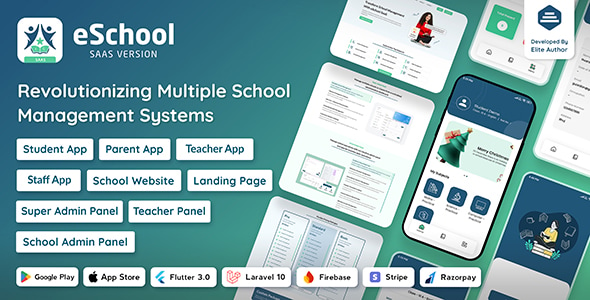eSchool SaaS - School Management System with Student, Parent, Teacher Flutter App & Laravel Admin
eSchool SaaS is a comprehensive and modern school management system designed to meet all the needs of educational institutions. Thanks to its SaaS (Software as a Service) architecture, it offers the ability to manage multiple schools through a single platform. This feature is particularly ideal for school chains or educational institutions with multiple branches.
The system features a powerful Laravel-based admin panel. Through this panel, school administrators can easily manage all operational processes of the school, such as student enrollment, academic calendar, class schedules, exam management, grade entries, staff management, financial transactions (fee tracking, invoicing), library, transportation, and inventory.
One of the most notable features of eSchool SaaS is the separately developed Flutter-based mobile applications for students, parents, and teachers. Thanks to these applications:
-
Students: Can track their class schedules, homework, exam results, announcements, and communicate with their teachers.
-
Parents: Can instantly monitor their children's academic progress, attendance, exam results, and school announcements, and easily communicate with teachers and school administration.
-
Teachers: Can take attendance, assign homework, create exams, enter grades, and communicate with students and parents.
The system allows for specific authorization for each user type through advanced role and permission management, ensuring the highest level of data security. The instant notification system quickly delivers important announcements, events, or emergencies to all users. Additionally, communication channels can be diversified with email and SMS integrations.
eSchool SaaS contributes to the digital transformation of educational institutions of all sizes with its user-friendly interface, customizable modules, and scalable structure. Developed with modern technologies, it ensures that the system can also meet future needs. Thanks to comprehensive reporting tools, school administrators can access detailed data on the institution's performance and make strategic decisions.
Installation Instructions
-
Upload the purchased files to your server.
-
Create a database and configure your database information in the .env file.
-
Ensure that the necessary PHP extensions are active on your server.
-
Run the installation wizard through your browser and follow the steps.
-
For detailed installation and configuration information, refer to the documentation provided with the product.
Update Version History
-
Version 1.3 – (February 15, 2024)
-
Version 1.2 – (January 30, 2024)
-
Version 1.1 – (January 17, 2024)
-
Major bug fixes
-
Feature improvements
-
Version 1.0 – (December 28, 2023)

